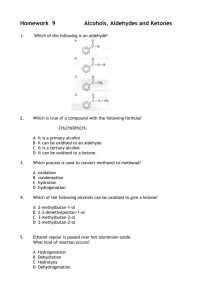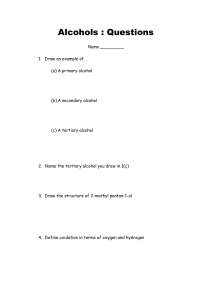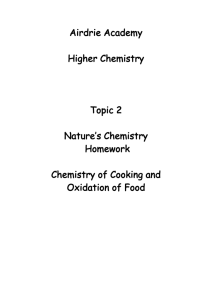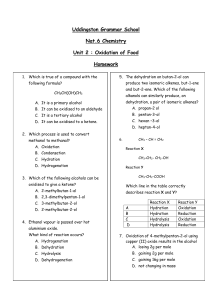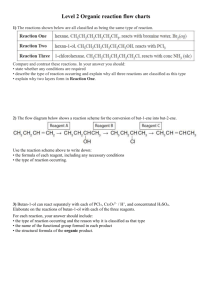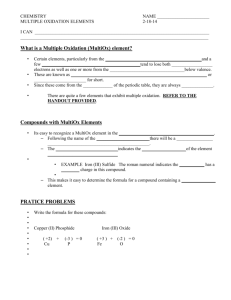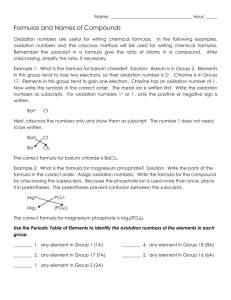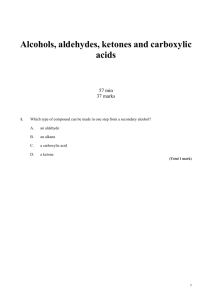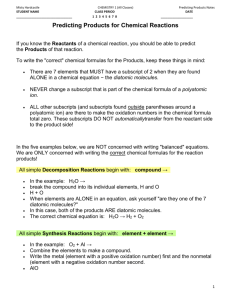Homework (D) The Chemistry of Food
advertisement
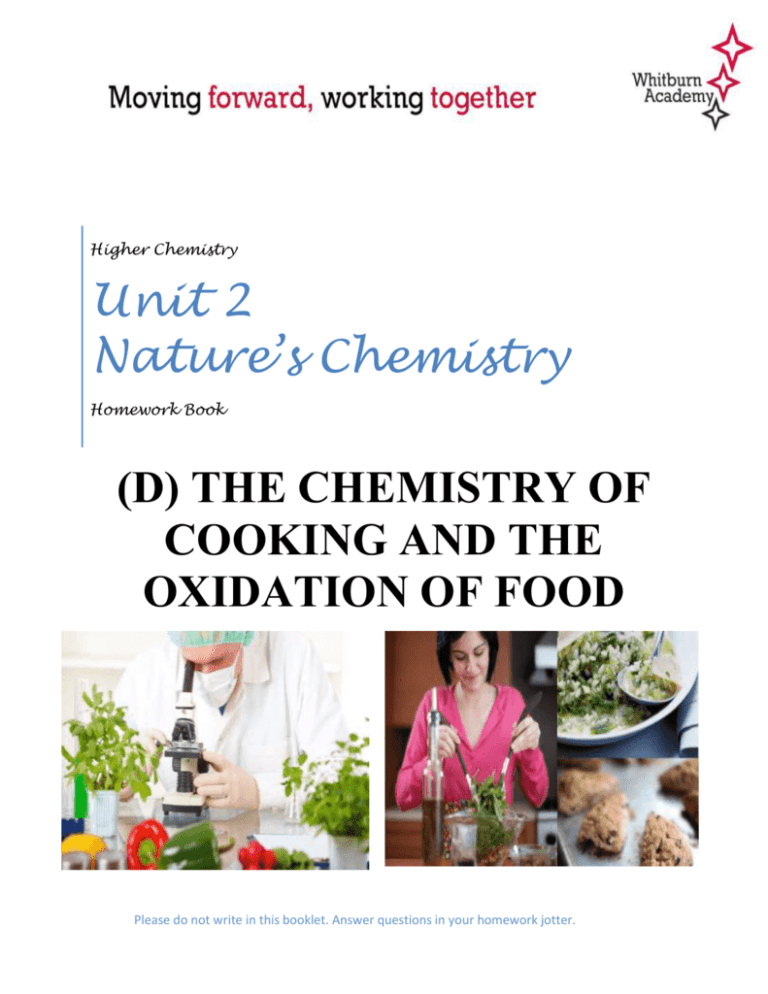
Higher Chemistry Unit 2 Nature’s Chemistry Homework Book (D) THE CHEMISTRY OF COOKING AND THE OXIDATION OF FOOD Please do not write in this booklet. Answer questions in your homework jotter. The Chemistry of Cooking and Oxidation of Food 1. What is the general formula for aldehydes and ketones? 2. What is the name of the functional group found in aldehydes and ketones? 3. Which of the following is an aldehyde? 4. Which is true of a compound with the following formula? CH3CH(OH)CH3 A B C D 5. Which process is used to convert methanol to methanal? A B C D 6. oxidation condensation hydration hydrogenation Which of the following alcohols can be oxidised to give a ketone? A B C D 7. It is a primary alcohol It can be oxidised to an aldehyde It is a tertiary alcohol It can be oxidised to a ketone. 2-methylbutan-1-ol 2,3-dimethylpentan-1-ol 3-methylbutan-2-ol 2-methylbutan-2-ol Ethanol vapour is passed over hot aluminium oxide. What kind of reaction occurs? A B C D Hydrogenation Dehydration Hydrolysis Dehydrogenation 1 8. After heating for several minutes as shown in the diagram, the pH indicator solution turned red. Liquid Q could be A B C D 9. propanone paraffin butan-1-ol butan-2-ol What compound is formed by the oxidation of propan-2-ol? A B C D CH3CH2CHO CH3CO CH3 CH3CH2COOH CH3CH2 CH2OH 10. During oxidation, what happens to the ratio of O:H atoms in a hydrocarbon? 11. Two compounds A and B, both have the formula C4H8O. They were both mixed separately with Fehling’s solution and the mixtures warmed in a water bath. Only compound B gave an orange-red precipitate. a) Name compounds A and B. b) Draw the extended structural formulae of A and B. c) Name another reagent which could also be used to show the difference between compound A and B and say what would happen when this reagent is reacted with A and B. 12. A CH3CH2OH B CH3CHOHCH3 C CH3CH2COOH D CH3COCH3 E CH3CH2CHO F CH3COOH Which box, or boxes, show(s) a substance which a) can be oxidised to an alkanal (aldehyde)? b) is an alkanone (ketone)? c) is an alkanoic (carboxylic) acid? d) is a primary alcohol? e) can be formed by the oxidation of B? 2 13. Propan-1-ol, can be oxidised by passing the alcohol vapour over hot copper(II) oxide. a) Draw a labelled diagram of the apparatus that would be used to carry out this experiment in the aboratory. b) Oxidation of propan-1-ol yields a compound X, formula C3H6O, which can be further oxidised to compound Y, formula C3H6O2. i) Name and draw the structure of compound X. ii) Name and draw the structure of compound Y. c) Name two other oxidising agents which could be used to carry out the oxidation. d) If propan-2-ol was used in place of propan-1-ol there would be only one oxidation product. Name and draw the structure of this product. 14. "Self-test" kits can be used to check the quantity of alcohol present in a person's breath. The person blows through a glass tube until a plastic bag at the end is completely filled. The tube contains orange acidified potassium dichromate crystals that turn green when they react with ethanol. The chemical reaction causing the colour change is: The more ethanol present in the person's breath, the further along the tube the green colour travels. a) What is the purpose of the plastic bag? b) Why are the potassium dichromate crystals acidified? c) Name a carbon compound formed by the reaction of ethanol with acidified potassium dichromate crystals. 15. Propanone is a widely used solvent. It can be made from propene. Using full structural formulae show the steps involved in this preparation and name the reagent used in each step. 3 16. Alkanols can be oxidised to alkanoic acids. CH3CH2CH2OH Propan-1-ol step 1 CH3CH2CHO propanal step 2 CH3CH2COOH propanoic acid (a) Why can step 1 be described as an oxidation reaction? (b) Acidified potassium dichromate solution can be used to oxidise propanal in step 2 . What colour change would be observed in this reaction? 17. Butan – 2-ol reacts in different ways dehydration butan-2-ol oxidation condensation with ethanoic acid butanone (a) Name the two products formed by the dehydration of butan-2-ol. (b) Name a reagent which could be used to oxidise butan-2-ol to butanone. 18. Two reactions involving a carbon compound, A, are shown. (a) Name compound A. (b) Draw a structural formula for compound B. (c) Name a substance used to convert compound A into but-2-ene and but-1-ene. 4 19. Give 3 ways that fatty foods are affected when they react with oxygen. 20. Why are antioxidants added to foods? 21. What is meant by a free radical? 22. Give the names of 3 natural antioxidants and state which foods they are found in. 23. Describe how orange juice can stop apples from going brown after they have been cut. 24. Apples and bananas turn brown when cut or bruised. The first step of the reaction causing the browning is shown below. What type of reaction is this? 25. A student closed his eyes and held his nose. Another pupil gave him a teaspoon of strawberry jam to eat. Explain why the student could tell that the food was sweet, but not what the actual flavor was. 26. Explain why broccoli should be cooked in water but asparagus should be cooked in oil. 5
